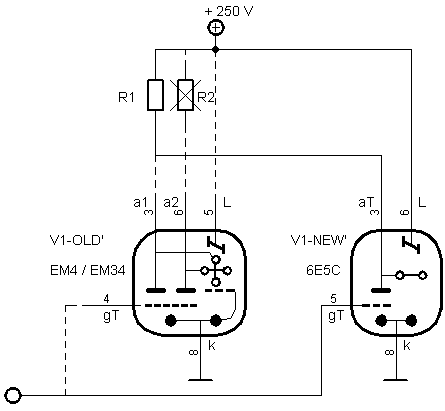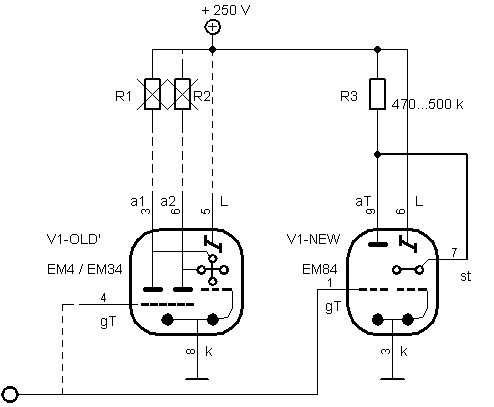Replacing the EM4 by the 6E5C
Replacing the EM4 by the 6E5C


In many cases it's possible to replace the rare and expensive eye tube EM4 by the Russian 6E5C (6e5s). (This 6E5C is an octal-base version of the American 6E5 (with UX6 Base)).
The EM4 has two shadow angles with different sensitivity, which requires two triode units inside the bulb with different amplification as control preamps.
Unlike to the EM4, the 6E5C has only one shadow angle, which then requires only a single triode.
Replacing the EM4 by a 6E5C requires either the change of the socket with adequate rewiring, or, as rather a kind of makeshift, the use of an interadaptor.
Note the base diagrams of the EM4 and the 6E5C for a proper rewiring.
The 1 MegOhm resistor R1 at a1 will be retained, while the former resistor R2 (at a2) will be dropped.


Replacing the EM4 by the EM84
In many cases it's possible to replace the EM4 magic eye by the magic bar tuning indicator EM84, as the example by the Philips BF510A clearly proofs.
On the left one can see the EM84 without input signal, which demonstrates that nothing of the indication sweep is left.
The space laterally of the EM84 fluorescent bar should be covered by suitable material and colour.
The EM4 has two shadow angles with different sensitivity, which requires two triode units inside the bulb with different amplification as control preamps.
Unlike to the EM4, the EM84 has only one moving pattern which then requires only a single triode.
Replacing the EM4 by a EM84 requires the change of the socket with adequate wiring.
Note the base diagrams of the EM4 and the EM84 for a proper rewiring.
Both the 1 MegOhm resistors R1 and R2 will be dropped and replaced by a new 470...500 kOhm resistor R3.
Additionally a jumper between anode triode (aT) and control rod (st) is required (pin 7 to 9).
Don't forget the rewiring of the heater connections.

To thank the Author because you find the post helpful or well done.